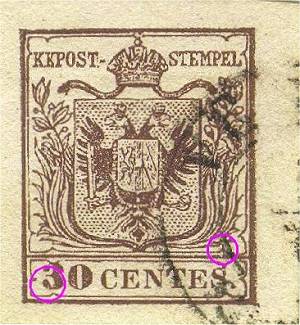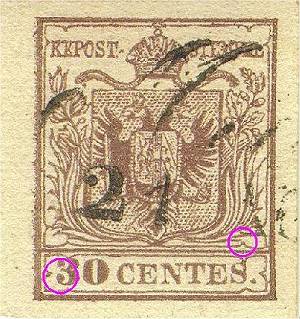30
CENTESIMI

This stamp was printed both with hand-made
as well as with machine-made paper (from May 1855) with thickness and quality
very variable, using the "original" coat of arms as well
as the "revised" one (see the issue introduction and the
"Going deep" section).
As for other values of this set, it's possible recognize the samples printed
with the first matrix, even if in this case somebody thinks that it is better
to talk about first stereotype coming from the unique used matrix. In fact
several studies confirm that only one matrix was used to prepare multiple
stereotypes.
The main recognition sign is a small interruption in the shield internal border,
on the left (Fig. 1).

Fig. 1: first matrix; border
interruption
For
the 30 centesimi we can identify two main types easy to recognize and well
known by collectors. Here is how to identify them:
1st
TYPE: number "3" with the lower part
flat, due to an impurity present in the minting die; tip of the lower right
internal ornament long and pointed (Fig. 2).

Fig. 2: first type
2nd
TYPE: number "3" with
the lower part regular and similar to a small ball (the whole "3"
to look in detail seems modified); tip of the lower right internal ornament
short and flat (the parts with machine-made paper are all of this type) -
Fig. 3 -

Fig. 3: second type
NOTE:
usually two stamps are classified of the second type, that overall differ for color shades quite different: dark brown and lilac
brown. I present here two samples just to show the clear difference in color
(Fig. 3a-3b). Also the engraving, to be correct, is different in some little details, with the first subtype showing a less accurate printing and the points of the coat of arms bigger than in the second subtype. It will surely be a pleasure for the specialized collector to deeply study these peculiarities...
|
|
|
|
|
Fig.
3a: brown
|
|
Fig.
3b:
lilac brown
|
Catalogued color shades (as per Sassone) - 1st type; hand-made paper
Brown (typical
color)
Pale brown (1st issue)
Brown (1st issue)
Dark brown (1st issue)
Dark brown
Grayish brown
Reddish brown
Deep dark brown
Catalogued color shades (as per Sassone) - 2nd type; hand-made paper
Dark brown (typical
color)
Grayish brown
Reddish brown
- - - - - - - - - - - - - - - - -
Lilac brown (typical color)
Pale lilac brown
Chocolate brown
Catalogued
color shades (as per Sassone) - 2nd type; machine-made paper
Brown (typical
color)
Reddish brown
Grayish brown
Brown gray (poor printing)





